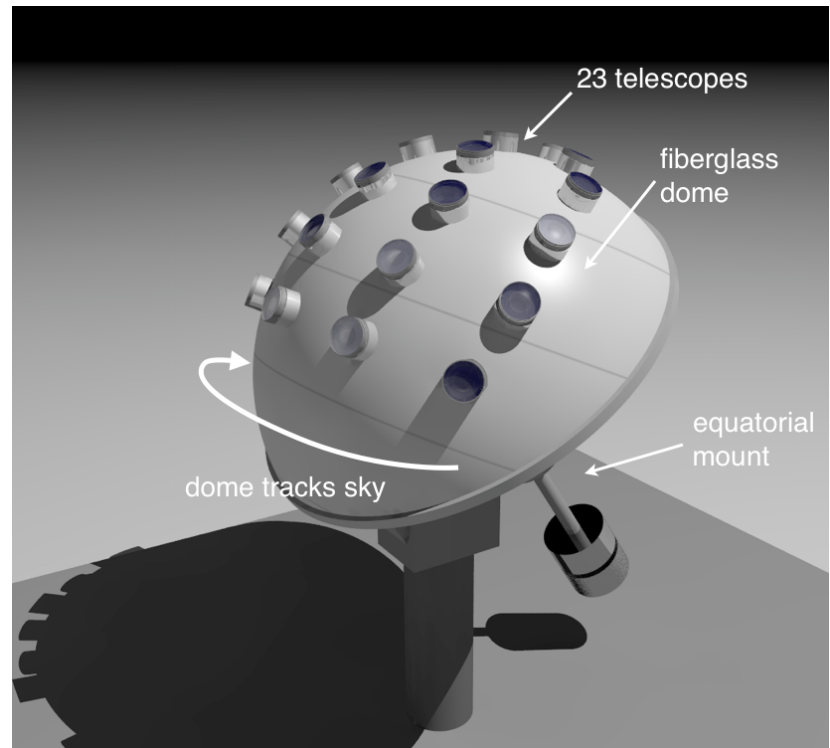How to Build an Evryscope
One problem with telescopes is that they can only peer at a tiny piece of sky at any one time. Astronomers have attempted to get around this by combining many images, each just a few degrees wide, that cover different areas of the sky. These state-of-the-art systems can produce a map of the entire sky every day.

But astronomers very well know that many interesting events occur on much shorter timescales, such as the transit of exoplanets across other stars, binary stars that eclipse, gamma ray bursts and so on. Capturing the changes associated with these events requires a much more rapid way of photographing the entire sky.
Today, Nicholas Law and pals at the University of North Carolina at Chapel Hill, say they are developing just such a piece of kit. Their new gigapixel-scale telescope will be capable of photographing the entire sky simultaneously and continuously at relatively low cost. Indeed, this instrument represents an entirely new type of telescope which Law and co call the Evryscope, from the Greek for “wide-seeing.”
The design is straightforward in principle. It consists of 23 small telescopes mounted on a hemispherical dome that can rotate to track the sky. Each small telescope has a 7 cm aperture and a field of view of a few hundred square degrees. Each one focuses light onto 29 megapixel chip.
The dome is designed so that the fields of view of each of the small telescopes overlap to cover around 10,000 square degrees of sky simultaneously and to produce 0.7 gigapixel images. The dome rotates on equatorial mount so that the Evryscope can record exposures of up to 3 hours before ratcheting back and tracking the next sky area.
That will produce 700 megapixel images every two minutes at a data rate of 5 MB per second. This will be stored on a 20 TB storage unit that should help to handle three months of data, assuming that the weather will be good two thirds of the time.
The small telescopes themselves are simple–essentially camera lenses sitting on top of CCD chips. Law and co have been experimenting with Canon 50mm and 85mm F/1 .2 lenses. And they’ve had two telescopes with these lenses operating automatically in the Arctic over the last two winters. They say the instruments have worked more or less perfectly with no humans even present much of the time.
Interestingly, the Canon 85 mm F/1 .2 costs around $2000. But Law and co say they’ve been testing a Rokinon 85 mm F/1.4 lens that produces similar results at a cost of only about $200, an order of magnitude less. If this turns out to be a feasible option, it could considerably reduce the cost of the Evryscope.
Either way, they say that they should have a prototype Evryscope operating next year. With only one moving part, the equatorial drive, the system should be reliable, an essential requirement for a device that will operate automatically without any human even present.
That could do some valuable work. Law and co say their Evryscope should be able to search for exoplanets around nearby bright stars and even look for rocky planets in the habitable zones around nearby M dwarf stars.
And because Law and co intend to store all the data produced by the Evryscope, it should also be handy for after-the-fact study of any event in the night sky. This will allow astronomers to examine the relevant area of sky in the days, weeks or even months before supernovas or gamma ray bursts, looking for interesting precursor events.
That will be an interesting piece of kit. “Evryscope systems offer a new capability: a continuously recorded image of a large fraction of the visible sky, with the ability to follow individual events and objects on minute-by-minute timescales in archival data,” say Law and co.
And they should do at the relatively low cost in the near future. “We expect to deploy a prototype of the Evryscope system in early 2015, with a full system following thereafter,” they say.
We’ll be watching to see what happens.
Ref: arxiv.org/abs/1407.0026 : The Evryscope: The first Full-Sky Gigapixel-Scale Telescope
Keep Reading
Most Popular
Large language models can do jaw-dropping things. But nobody knows exactly why.
And that's a problem. Figuring it out is one of the biggest scientific puzzles of our time and a crucial step towards controlling more powerful future models.
How scientists traced a mysterious covid case back to six toilets
When wastewater surveillance turns into a hunt for a single infected individual, the ethics get tricky.
The problem with plug-in hybrids? Their drivers.
Plug-in hybrids are often sold as a transition to EVs, but new data from Europe shows we’re still underestimating the emissions they produce.
Google DeepMind’s new generative model makes Super Mario–like games from scratch
Genie learns how to control games by watching hours and hours of video. It could help train next-gen robots too.
Stay connected
Get the latest updates from
MIT Technology Review
Discover special offers, top stories, upcoming events, and more.